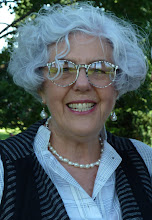Stepping through the wrought iron gateway of our hotel onto the narrow, congested street was a small but momentous act for me. The emotions running through my head and heart were huge. I'm here. This is Lhasa, Tibet. Turning right, my back to the main, westernized thoroughfare at one end of the narrow street, I strolled toward the heart of the Barkor - the center of spiritual Lhasa. I was stopped by the view of a non spiritual, but necessary item of daily life in Tibet, yak butter! One of the ingredients of yak butter tea, the piece on the table must have weighed several pounds. I did wonder if Tibetans use yellow food coloring in their butter too? Don't think yak milk comes out that color. But somehow that measure of daily life grounded me.
 |
| Yak butter |
|
Walking slowly on, trying not to gape as I took in the sights, sounds, smells and activities around me, I arrived at a 'T' and stopped. Quietly making their way from my right - in a clockwise direction - lips moving, prayer beads slipping through fingers, prayer wheels spinning in many hands - were Tibetans dressed traditionally or in more westernized clothing - making their way around the Jokhang Temple ... the heart of the Barkor. Some chatted with companions as they walked, others moved in silence. I had previously witnessed such a procession of Tibetan refugees around the great stupa in Kathmandu, Nepal. But here it was Tibetans, in Tibet, circumambulating this most sacred of temples. I could only stare through my tears. A continuous line of pilgrims stretched for blocks as they waited along the wall of the Jokhang for admission to the temple.
 |
| Circumambulating the Jokhang |
On both sides of the street were merchants, selling just about anything you could imagine: souvenirs of every kind - hand made and commercially produced, household items, food items, raw foods, cooked food to eat, statuary of every size and shape, prayer flags by the thousands ... it was dizzying. Who was shopping? The people in my group, Tibetans, Chinese tourists, monks ... and looking at the photos I took - there were so many things I didn't really see, mostly because it was all just a bit overwhelming.
 |
| Note the woman on the stool, right, with traditional turquoise hair ornaments. |
 |
| The sacred and the saucepans - side by side |
And amongst the congestion and commerce appeared a small fairy ... wings and all! I walked on behind her, as her mother tried to hurry her along ... she wanted to pause and look at everything - and finally I couldn't resist taking her photo.
 |
| Tibetan fairy! |
Walking on there was a sudden flare of intense white smoke. It was difficult to see where it was coming from. Finally we could see an enormous incense burner which had obviously just had an addition of (probably) cedar branches added to it. Most of the large censers we saw, in all of our travels in Tibet, were being fed with cedar branches.
 |
| Jane, from our group, walking toward a military watch point. |
It is forbidden to take photos of the police or the military in Tibet and China. Fascinated by the burst of white smoke, I took the photo totally oblivious to the fact that I had captured one of the military watching posts that are placed at regular intervals around the Jokhang temple - following the upheavals in the city in 2008. I later witnessed a soldier stop someone who had taken a photo that displeased them, demand to see the image and then tell the person to delete the image ... and watched as the man did so! The watching posts are manned by four soldiers bearing semi-automatic large guns - two of them facing each direction. They are ever vigilant. Later in our stay Amy and I adjourned to a rooftop restaurant for a cup of tea and to rest. Sensing someone was watching me I looked around and it wasn't until I looked to an adjoining building that I realized there were soldiers, with guns, phones and binoculars watching us, as well as the square below. Posing Amy carefully, the soldier under the lavender colored umbrella can clearly be seen behind her.
 |
| The observed - Amy |
 |
| The observer. |
Thinking about that first exposure to Lhasa ... fully aware that it was no longer a small city with a totally spiritual focus ... but a city that had long been under the control of the Chinese government and one which the Chinese have very purposefully peopled with Han Chinese immigrants .... it was the vibrancy and vitality on the faces of the Tibetans we encountered on our first walk around the Jokhang temple that (perhaps foolishly) was somehow reassuring. My amazement and gratitude at actually being there never diminished. I recognize now that trying to collect together my thoughts and emotions around such an experience will be a much more complex undertaking than I had first imagined.



















